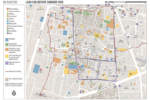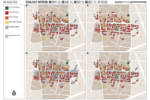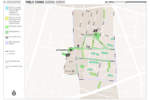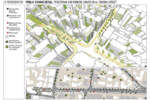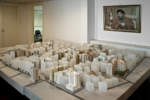The municipality of Beirut comprises twelve districts that together occupy an area of about 100 kmq; the urban tissue continues without breaks southwards and eastwards, with the municipalities of the metropolitan area, along the directrix of the road to Damascus. The variegated social composition of the city is reflected by the distinct identity of the different areas, which has become even more marked after the Civil War, and by the different ways to manage the urban growth.
The municipality has recently intensified its efforts to introduce shared regulatory elements in sectors that are generally reluctant to implement indications of a general kind. Among the experiences in which town planning proposals have had to deal with political and sectarian requirements, some stand out by virtue of the intensity with which the processes are developed. Mona Fawaz of the American University of Beirut speaks about the case of Dahiye, the Shiite district that was bombarded by the Israeli aviation in 2006. The urban observatory of Majal has been active for years on the semi-central area of Zokak El-Blat, while the architect and urbanist Diran Harmandayan describes the urban situation of the Armenian district of Bourj-Hammoud
The reconstruction of Dahiye
interview to Mona Fawaz
Nicola Santini: You were involved in the reconstruction project for Dahiye, can you talk about this experience?
Mona Fawaz: During its blitz of Lebanon in the summer of 2006, the Israeli military ravaged the neighborhood of Haret Hreik in the southern suburbs of Beirut, razing to the ground over 200 multi-story residential, commercial, and office buildings, and displacing thousands of households in what Human Rights Watch described as Israeli “war crimes”. But beyond the sheer tonnage of ordinance targeting Haret Hreik was the symbolic violence attempting to erase the body-politic which had produced this space. Paralleling the September 11, 2001 attack on New York’s World Trade Center, the city was invoked by Israeli war planners as a party to the conflict; erasing a neighborhood or a number of buildings amounted to undermining the life-support of an enemy, in this case HizbAllah that had established its national headquarters in the neighborhood. This symbolic and tangible act of war was not missed by Hezbollah that immediately described, in the words of its secretary general, the reconstruction of the Southern Suburbs of Beirut as an act of self-affirmation. On the first day of the cease-fire, Sayyed Hassan Nasrallah pledged: “Everything will be rebuilt more beautiful than it was“.
N.S.: How you got involved in the reconstruction of Dahiye? And what was your proposal?
M.F.: I first got involved because I felt directly injured by the Israeli war on Lebanon. Haret Hreik is much more than a political headquarter. The neighborhood is a socially and commercially vibrant part of the city; it is also the heart of the southern suburbs of Beirut (also known as Dahiye), a territory which was associated with the urbanization of the Muslim Shiite community in Lebanon well before it housed Hezbollah’s headquarters. In Haret Hreik, the so-called Israeli Defense Forces had demolished the lives of over 20,000 households, they ravaged the social and commercial space of many others. With colleagues at the American University of Beirut, we then formed the Reconstruction Unit in the Department of Architecture and Design and worked in several sites. I was part of the group that got involved with the Municipality of Haret Hreik, which was supportive of our involvement. We attempted to organize an international urban design idea competition to involve planners and designers from the whole world in rethinking the post-war reconstruction of this dense neighborhood. The Order of Engineers and Architects, the Municipality, and several high-ranking members in Hezbollah were supportive of our ideas. Unfortunately, the project didn’t materialize.
N.S.: For what reason?
M.F.: The Hezbollah leadership eventually vetoed the idea. From what I gather, the Party was reluctant to enter a lengthy design process that would involve negotiations with public authorities. Based on previous experiences, they expected huge delays… The Party dreaded a population displacement that would work against its own interest: it sought to maintain its territorial base. As a result, they defined the post-war reconstruction strategy in the narrow terms of restituting all private properties to pre-war owners, in the same volume, sizes, and locations that had existed at the time of their demolition in 2006. Although they described this goal as a response to the dwellers’ demands, I think this is incorrect because interviewed dwellers at the time had expressed strong hopes that open spaces and better pedestrian circulation would be established. This is why I think that the dwellers had a strong concern about the public realm, which was unfortunately lost in this reconstruction.
Our task quickly became about reclaiming the “public realm” in this reconstruction and arguing for the necessity to begin urban interventions from the “public” rather than the “private”. We organized a workshop at AUB, where we involved a large number of planners, architects, and others to think about the reconstruction from the public premise and we presented our work to stakeholders and in many public venues. One of the most powerful moments I recall was in the Order of Engineers and Architects, during a public presentation when the planning agency set-up by Hezbollah, Wa‘d, presented its project and we presented our counter-project. Seeing that we had suggested a network of public spaces, and despite the fact that our intervention didn’t cause any displacement, one of the neighborhood dwellers loudly contested our project arguing: “look at all these open spaces, this is inacceptable, you are displacing half the population.” We had only used left over spaces and closed up an 8 meters wide road. Somehow, the possibility of a public space had been erased in the imagination of the neighborhood dwellers.
N.S.: Even if they are two completely different cases, do you think there are analogies between Solidere and Dahiye reconstructions?
M.F.: Solidere and Haret Hreik are quite comparable. The projects are both private initiatives, where the State is delegating to the private sector decisions about the future of the city. The planning is staged in top-down, centralized logics that seek the accumulation of financial capital in the case of Solidere and political capital, in the case of Haret Hreik. In both cases, we are reducing the possibilities for stakeholders to lay claim on shaping or transforming their spaces in the city. What is ironic is that in both cases, claims are made against the city. Thus, Solidere is a beautiful and clean project that rejects the rest of the city as dirty and backward and the new Haret Hreik is a pious, resistant, and politically engaged neighborhood that turns its back to the corrupt city.
N.S.: And the final masterplan for Haret Hreik was made by whom?
M.F.: The decision was taken at the level of the Hezbollah political bureau to set-up a commission formed of distinguished local figures in architecture who were asked to develop a “master plan” for the area. The commission met regularly for months and worked within the guidelines dictated by the political: no population displacement, no changes in the volumes or locations of buildings, etc. The main improvement they implemented was in introducing underground parking to buildings which will eventually ease a dire street level congestion.
N.S.: How do you see the future of Dahiye?
M.F.: The future of Dahiye is like the future of Beirut: jungle of traffic jams and construction. No one thinks of the “public” in this city.
Mona Fawaz
has worked since graduation on the restoration of an office building in downtown Beirut, on the design of the region adjacent to the projected North Lebanon Highway, on low income housing in the informal settlement of Hay-el-Sellom south of Beirut, and on Islamic architecture and urban organization.
In 1996 she joined the Department of Urban Studies and Planning at the Massachusetts Institute of Technology. While studying at MIT, Fawaz was actively involved in research projects, studying infrastructure in developing countries, upgrading Palestinian camps in Gaza, the West Bank, and Jordan, and investigating state policies for regularizing informal land and housing settlements.



